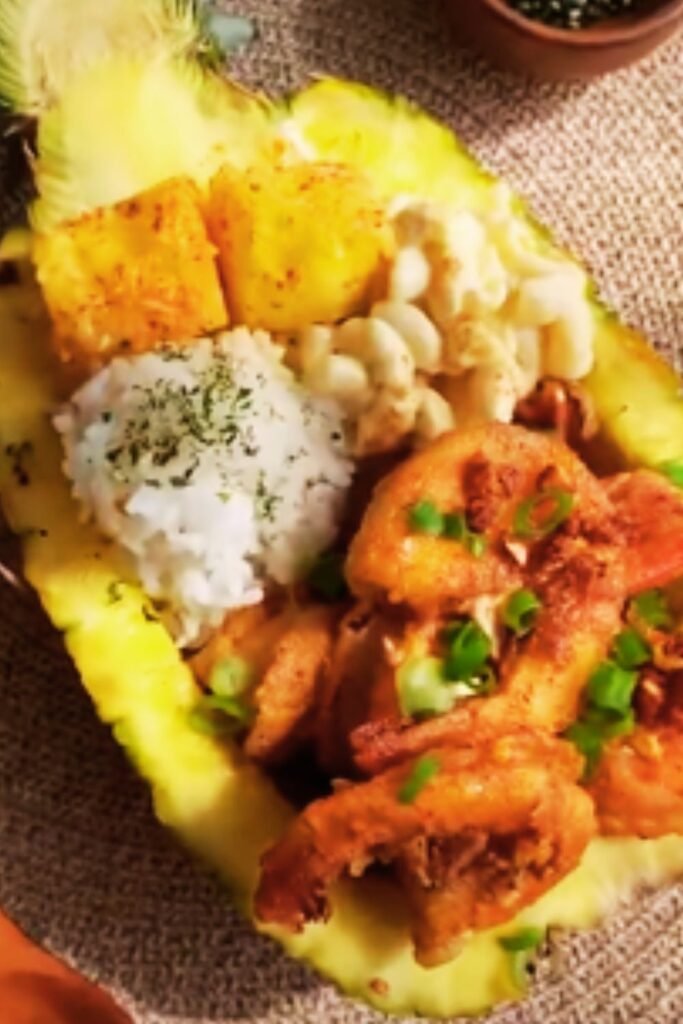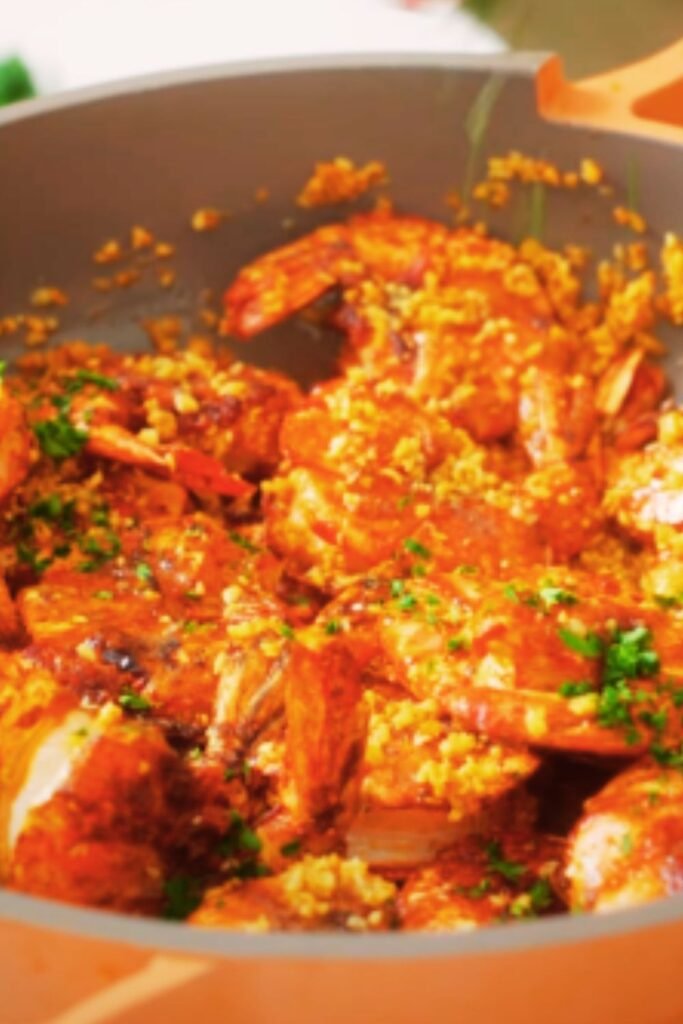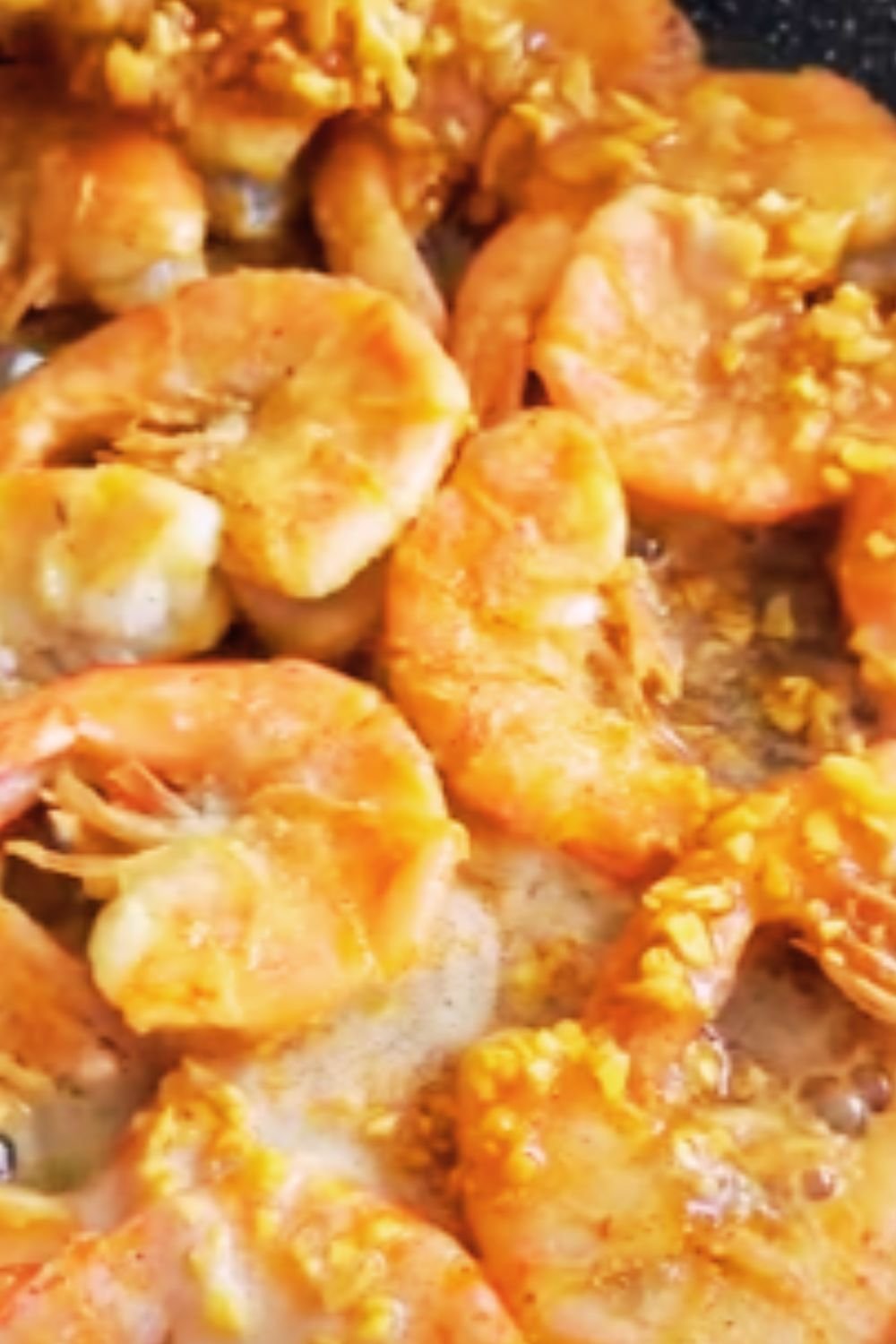Have you ever tasted those mouthwatering garlic shrimp from the food trucks on Oahu’s North Shore? I still dream about them years after my Hawaiian vacation. The combination of succulent shrimp bathed in garlicky butter sauce, served with fluffy white rice, has become legendary for good reason. Today, I’m sharing my take on this island favorite, with a special sweet twist that takes it to a whole new level.
The Story Behind Hawaiian Garlic Shrimp
My first encounter with Hawaiian garlic shrimp came during a spontaneous stop at Giovanni’s Shrimp Truck. Standing in line, watching locals and tourists alike waiting patiently for their paper plates piled high with shrimp, I knew I was in for something special. That first bite—buttery, garlicky, with a hint of lemon—was revelatory.
Hawaiian garlic shrimp (or scampi) represents the beautiful fusion of cultures that makes Hawaiian cuisine so unique. This dish combines traditional Mediterranean garlic preparation techniques with Asian influences and local Hawaiian ingredients. The food trucks that made this dish famous primarily emerged in the 1990s, but the recipe itself has roots in Hawaii’s plantation era when Filipino, Japanese, Chinese, Portuguese, and Hawaiian cooking methods all blended together.
What sets Hawaiian-style garlic shrimp apart is that the shrimp are typically cooked shell-on, which locks in moisture and flavor. They’re then tossed in a sauce that’s unapologetically heavy on garlic—we’re talking tablespoons, not teaspoons!
My Sweet Twist
While traditional Hawaiian garlic shrimp is perfection on its own, I’ve developed a variation that incorporates a sweet element—caramelized pineapple and a touch of honey—that complements the savory garlic beautifully. This sweet-savory balance is characteristic of many Hawaiian dishes and creates a more complex flavor profile that will have your family and friends begging for the recipe.
Ingredients You’ll Need
For the garlic shrimp:
- 2 pounds large shrimp (21-25 count), shell-on and deveined
- 16-20 cloves garlic (yes, really!), minced
- 1/2 cup unsalted butter
- 1/4 cup olive oil
- 1 teaspoon paprika
- 1 teaspoon sea salt
- 1/2 teaspoon black pepper
- 1/4 teaspoon cayenne pepper (adjust to taste)
- 2 tablespoons flour (for light coating)
For the sweet twist:
- 1 cup fresh pineapple, diced into small chunks
- 2 tablespoons honey
- 1 tablespoon brown sugar
- 1 tablespoon soy sauce
- Juice of 1 lime
For serving:
- 2 cups cooked white rice
- 4 tablespoons chopped fresh cilantro
- 4 green onions, thinly sliced
- Lime wedges
Equipment Needed
- Large skillet or wok
- Mixing bowls
- Sharp knife and cutting board
- Garlic press (optional, but helpful)
- Measuring cups and spoons
- Wooden spoon or heat-resistant spatula
Preparation Steps
Step 1: Prepare the Shrimp
I like to keep the shells on my shrimp for authentic Hawaiian style, but I do make sure they’re properly deveined for cleaner eating. Here’s how I prepare them:
- Rinse the shrimp under cold water
- Using kitchen scissors, cut along the back of each shrimp to expose the vein
- Remove the vein but leave the shells intact (including tails)
- Pat the shrimp completely dry with paper towels (this is crucial for a good sear)
- In a bowl, combine the shrimp with 2 tablespoons of minced garlic, 1 tablespoon olive oil, and a pinch of salt
- Let marinate for 15-20 minutes (but not longer, as the acid can start to “cook” the shrimp)
Step 2: Make the Sweet Pineapple Sauce
While the shrimp marinates, I prepare my sweet pineapple component:
- Heat a small saucepan over medium heat
- Add the diced pineapple, honey, brown sugar, and soy sauce
- Cook for about 5-7 minutes, stirring occasionally, until the pineapple begins to caramelize and the mixture thickens slightly
- Remove from heat and stir in the lime juice
- Set aside to cool slightly

Step 3: Cook the Garlic Butter Base
Now for the star of the show—that incredible garlic butter sauce:
- In a large skillet or wok, melt the butter with the remaining olive oil over medium heat
- Add the remaining minced garlic (yes, all of it!) and cook for about 1-2 minutes until fragrant but not browned (burnt garlic turns bitter)
- Add the paprika, salt, pepper, and cayenne, stirring to combine
- Cook the aromatic mixture for another minute to allow the flavors to bloom
Step 4: Cook the Shrimp
This is where the magic happens:
- Lightly dust the marinated shrimp with flour, shaking off any excess
- Increase the heat to medium-high
- Add the shrimp to the garlic butter sauce in a single layer (work in batches if needed to avoid overcrowding)
- Cook for approximately 2 minutes per side until the shells turn pink and slightly crispy
- Be careful not to overcook—shrimp can go from perfect to rubbery in seconds!
Step 5: Combine and Serve
Time to bring it all together:
- Reduce heat to low
- Add the caramelized pineapple mixture to the skillet with the shrimp
- Gently toss to coat the shrimp with the sweet-savory sauce
- Cook for another 30 seconds to warm everything through
- Serve immediately over white rice
- Garnish with fresh cilantro and green onions
- Add lime wedges on the side for squeezing over the top

Nutritional Information
Here’s a breakdown of what you’re getting in each serving of my Hawaiian Garlic Shrimp with a Sweet Twist:
| Nutrient | Amount per Serving |
|---|---|
| Calories | 425 |
| Protein | 32g |
| Carbohydrates | 26g |
| Dietary Fiber | 2g |
| Sugars | 8g |
| Fat | 22g |
| Saturated Fat | 11g |
| Cholesterol | 285mg |
| Sodium | 760mg |
| Potassium | 410mg |
| Vitamin A | 15% DV |
| Vitamin C | 20% DV |
| Calcium | 15% DV |
| Iron | 20% DV |
Note: Nutritional values are approximate and based on 1/4 of the recipe with 1/2 cup cooked rice.
Tips for Perfect Hawaiian Garlic Shrimp
I’ve made this dish countless times, and here are some insights I’ve gained along the way:
Choosing the Right Shrimp
- Size matters: I recommend large shrimp (21-25 count per pound) for this recipe. They’re meaty enough to stand up to the strong flavors but cook quickly enough to stay tender.
- Fresh vs. frozen: While fresh is always wonderful, high-quality frozen shrimp that’s been properly thawed works perfectly fine.
- Shell-on is traditional: Cooking with the shells on adds tremendous flavor and helps prevent overcooking. However, if you prefer shell-off, reduce the cooking time by about 1 minute per side.
- Wild vs. farmed: Wild-caught Pacific shrimp offer the best flavor, but sustainable farmed options can be a good choice too.
Garlic Preparation
- Fresh is non-negotiable: Pre-minced garlic from a jar won’t give you the same vibrant flavor as fresh.
- Mincing methods: For the most even flavor distribution, I prefer to finely mince my garlic with a sharp knife rather than press it, which can make it bitter.
- Prevent burning: Keep a close eye on your garlic when cooking—the line between golden and burnt is thin, and burnt garlic will ruin your dish.
Cooking Technique
- Don’t crowd the pan: Cook shrimp in batches if necessary. Overcrowding leads to steaming rather than searing.
- High heat is key: That initial sizzle when the shrimp hit the pan creates caramelization and flavor.
- The flip test: I know it’s time to flip the shrimp when the edges of the shell turn pink and slightly opaque, usually about 2 minutes.

Variations to Try
My recipe is versatile and can be adapted in several delicious ways:
Spicy Version
- Double the cayenne pepper
- Add 1-2 Thai bird chilies, thinly sliced
- Include 1 teaspoon of chili garlic sauce in the marinade
Coconut Variation
- Replace half the butter with coconut oil
- Add 1/4 cup coconut milk to the sauce
- Include 2 tablespoons of toasted coconut flakes as a garnish
Lemongrass Infusion
- Add 2 tablespoons of minced lemongrass to the garlic butter
- Include 1 teaspoon of grated ginger
- Substitute cilantro with Thai basil
Make It a Bowl
- Serve over brown rice or quinoa instead of white rice
- Add sliced avocado and edamame
- Drizzle with sriracha mayo for extra flavor
Make-Ahead and Storage Tips
While this dish is best enjoyed fresh off the stove, here are some ways to manage time and leftovers:
Prep Components Ahead
- Garlic: Can be minced up to 24 hours ahead and stored in an airtight container in the refrigerator
- Pineapple sauce: Can be made up to 2 days ahead and reheated gently before combining with shrimp
- Shrimp: Can be deveined and marinated up to 4 hours before cooking
Storing Leftovers
- Refrigeration: Store in an airtight container for up to 2 days
- Reheating: Gently warm in a skillet over medium-low heat with a splash of water to revive the sauce
- Not recommended for freezing: The texture of the shrimp and the consistency of the sauce will suffer
Serving Suggestions
This dish is a star on its own, but here are some complementary sides and accompaniments:
Side Dishes
- Coconut rice
- Hawaiian macaroni salad
- Grilled pineapple slices
- Asian-inspired coleslaw
- Cucumber sunomono (Japanese vinegar salad)
Beverages
- Tropical iced tea with pineapple chunks
- Passion fruit lemonade
- Coconut water
- Pineapple ginger mocktail
- Sparkling water with lime
The Cultural Significance
Food in Hawaii is never just about eating—it’s about community, celebration, and the blending of cultures. Hawaiian garlic shrimp exemplifies this fusion, drawing from multiple culinary traditions while creating something uniquely island-inspired.
The North Shore shrimp trucks represent more than just delicious food; they’re cultural institutions where locals and tourists alike gather to enjoy simple but perfectly executed dishes. These unpretentious eateries, often housed in converted vehicles with picnic table seating, showcase Hawaii’s casual approach to exceptional food.
By making this dish at home, you’re participating in this rich tradition. When I serve this to friends and family, I love sharing the story behind it and how these humble food trucks have created a dish worthy of the finest restaurants.
Sustainability Considerations
When preparing this dish, I try to make environmentally conscious choices:
- Sustainable shrimp: Look for MSC-certified wild shrimp or responsibly farmed options with ASC certification
- Local ingredients: Whenever possible, source ingredients locally, especially if you’re fortunate enough to live somewhere with fresh pineapple
- Reduce waste: Use shrimp shells to make a flavorful stock for future recipes
- Conscious consumption: Purchase only what you need and properly store leftovers to minimize food waste
Common Questions and Answers
Q: Can I make this with shelled shrimp instead?
Yes, you can use peeled and deveined shrimp if you prefer easier eating. Just reduce the cooking time slightly (about 1-2 minutes per side) to prevent overcooking. You’ll lose some flavor, but the dish will still be delicious.
Q: How spicy is this dish?
With the amount of cayenne pepper specified (1/4 teaspoon), the dish has just a pleasant warmth that complements the sweetness. For a milder version, omit the cayenne altogether. For more heat, increase to 1/2 or even 1 teaspoon, depending on your preference.
Q: Can I substitute fresh pineapple with canned?
While fresh pineapple provides the best flavor and texture, you can use canned pineapple in a pinch. Choose pineapple chunks in juice (not syrup) and drain well. You may want to reduce the added sugar slightly since canned pineapple is often sweeter.
Q: Is there a dairy-free alternative to butter?
Absolutely! You can substitute the butter with additional olive oil, coconut oil, or a plant-based butter alternative. Each will give a slightly different flavor profile, with coconut oil particularly complementing the tropical pineapple notes.
Q: What can I do with leftover pineapple?
Leftover fresh pineapple can be frozen for smoothies, added to salsa, grilled as a side dish, or pureed and frozen in ice cube trays to add to cocktails or mocktails. You can also make a quick pineapple jam by cooking it down with a bit of sugar and lime juice.
Q: How do I devein shrimp while keeping the shells on?
Use kitchen scissors to carefully cut along the back of the shrimp, exposing the dark vein. Remove the vein with the tip of the scissors or a small knife, but leave the shell intact. It’s a bit more work but results in more flavorful shrimp.
Q: Can I make this dish ahead for a party?
This dish is best served immediately after cooking. If you need to prepare ahead, I suggest prepping all components separately: marinate the shrimp, prepare the garlic butter mixture, and make the pineapple sauce. Then quickly cook everything just before serving.
Q: What’s the best way to mince so much garlic?
For large quantities of garlic, I find it easiest to separate and peel all the cloves first. Then, I roughly chop them all, gather them back into a pile, and continue mincing until I reach the desired consistency. A food processor can also work, but be careful not to puree the garlic.
A Personal Note
The first time I made this recipe for friends, there was a moment of silence around the table as everyone took their first bite, followed by a chorus of “Oh my goodness!” and “This is incredible!” It’s one of those dishes that seems simple but delivers complex flavors that keep you coming back for more.
What I love most about this Hawaiian garlic shrimp recipe is how it transports me back to that sunny day on Oahu’s North Shore, sitting at a weathered picnic table with the ocean breeze in my hair. Food has this magical ability to connect us to places and experiences, and I hope this recipe brings a little bit of that Hawaiian magic to your table, wherever you may be.
Whether you’re cooking for a special occasion or just wanting to bring some island vibes to a weeknight dinner, this Hawaiian garlic shrimp with a sweet twist is sure to become a favorite. The combination of buttery garlic sauce, succulent shrimp, and sweet caramelized pineapple creates a taste experience that’s truly greater than the sum of its parts.
So pick up some fresh shrimp, gather an abundance of garlic, and get ready to transport your kitchen to Hawaii’s North Shore. Your taste buds will thank you for the journey!
Mahalo for Reading!
I hope you enjoy making and eating this Hawaiian garlic shrimp as much as I do. If you try this recipe, I’d love to hear how it turned out for you. Each time you make it, you might discover a new twist or technique that makes it even better. That’s the beauty of cooking—it’s always an adventure, just like those spontaneous stops at food trucks on Hawaiian highways that lead to unforgettable culinary discoveries.


